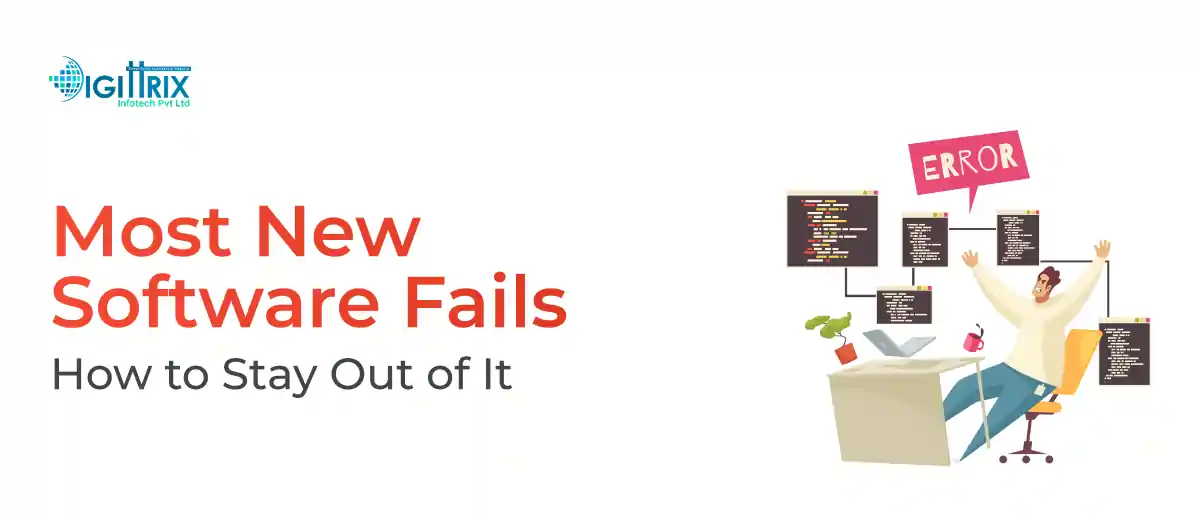Most new software fails due to poor planning, delays, high costs, and not meeting users' needs or business goals clearly and completely.
Highlights
An enthusiastic developer and skilled business management expert with over a decade of experience in the field

Launching new software is a significant milestone for any business or entrepreneur. Whether it's a mobile app, a customised software solution, or a website, the excitement is usually high. Everyone hopes it will meet users’ expectations, help the business grow, and generate a return on investment. However, the reality is often different.
Most new software projects fail. That may sound harsh, but it’s a fact. Failure doesn’t always mean a total disaster it could mean the app never gains enough users, the software becomes hard to maintain, or the costs outweigh the benefits.
The good news? Failure isn't unavoidable. By recognising common mistakes and taking practical steps early, your software project has a much better chance of success.
Let’s take a close look at why most software projects fail and what you can do differently.
Looking to grow your business? Learn why custom software is a smart investment to scale and succeed.
One of the most common causes of software failure is not understanding what end-users genuinely need. Too often, businesses begin development based on assumptions. They guess what users want instead of taking the time to research and gather feedback.
This often leads to a mismatch between what is built and what users will use.
Jumping into development without clear goals or a roadmap can easily lead to disaster. It’s vital to define what the software should do, how it will do it, and what success looks like.
Without clear planning, teams can lose focus. The project grows bigger than expected, deadlines are missed, and the software ends up with many unnecessary features.
Many new software projects fail because they lack a solid foundation. Software architecture is like the blueprint for your house. If it’s poorly designed, you’ll face issues later, bugs, crashes, slow performance, and high maintenance costs.
Custom software development needs careful planning of how all components work together. Ignoring this causes unstable or insecure products.
Software development can become expensive, especially if scope creep occurs when additional features are added midway through the project. Unexpected costs may arise from miscalculations, changes in project requirements, or technical problems.
This leads to either unfinished projects or low-standard products being launched because of limited funds.
Many software projects involve multiple people: developers, designers, testers, product managers, and stakeholders. If communication is unclear or infrequent, misunderstandings happen. Tasks may be duplicated, bugs missed, or development based on incorrect assumptions.
Clear, simple, and timely communication can help keep everyone aligned.
There’s often pressure to launch software quickly, whether to beat competitors or satisfy investors. However, releasing a product too early without proper testing can lead to negative outcomes. Users might face bugs, crashes, or a poor experience, and once trust is lost, it’s hard to regain.
This is particularly important for on-demand app development, where users expect seamless performance and prompt response times.
Launching the software is only the start. Many projects fail because they overlook planning for updates, maintenance, and customer support after launch.
Bugs will crop up. Users will have questions. New features will be required. Without a plan to manage all that, users will depart.
Whether you're working with freelancers, a mobile app development team, or a full-service web development company, the people building your software are very important. Choosing the wrong partner can lead to delays, poor code quality, or even project abandonment.
Some businesses select a custom website development company solely based on price. But cheaper isn’t always better. It’s about getting value for your money, not just the quote.
Markets change fast. What users wanted six months ago might be different now. If your software doesn’t adapt, it becomes outdated.
This is especially true in industries like health, retail, or logistics, where technology moves quickly. On-demand apps need to evolve based on changing user behavior and competition.
Bugs and glitches are common in development, but neglecting testing or leaving it to the last minute raises the risk of failure. Testing isn’t just about finding bugs it’s about ensuring your software works smoothly across different devices, platforms, and network conditions.
Users won’t give you a second chance if their first experience is full of errors.
Instead of developing a large product from the beginning, focus on the core idea. What is the one thing your users genuinely need? Build that first and test it. This is called the Minimum Viable Product (MVP) approach. It saves money and helps you learn what truly matters to your users.
Whether you're exploring custom software development or on-demand app development, success relies on your team. Collaborate with people who ask questions, understand your users, and prioritise quality.
If you don’t have an in-house team, look for a web development company that takes the time to understand your goals and provides honest feedback. Avoid those who promise too much too soon or don’t inquire about the purpose of the app or site.
User experience is everything. It’s not just about nice design. It’s about whether the user can achieve what they want quickly and without frustration.
Even if your software has powerful features, poor user flow or confusing menus will cause people to uninstall or leave.
Success isn’t just about launching the software. It's about keeping it useful. Update regularly, fix bugs quickly, and add features based on user feedback. Monitor your data to see which features are used most. Where do users drop off? Use that data to shape your product’s future.
Want to pick the best development path? Read Agile vs Waterfall: Which Software Development Method Is Best to help you decide between flexible iteration and structured planning.
Building successful software is challenging, but far from impossible. By understanding why most projects fail, you’re already ahead. Whether you're starting a mobile app, a custom website development project, or any digital solution, focus on clear planning, user needs, quality, and adaptability.
Use your resources wisely. A trusted web development company or dedicated developers can make a big difference. Invest time in planning, testing, and listening — and you’re much more likely to end up with a software product that not only works but lasts.
The software market is full of stories where things didn’t go as planned. But there are also plenty of successes built on preparation, practical thinking, and continuous effort. Let your project be one of those success stories.
Many businesses invest in new software with high hopes, only to face delays, bugs, or poor user response. At Digittrix, we understand what causes most software to fail — and more importantly, how to avoid it. With over 14 years of experience in custom software, mobile app, and website development, we guide businesses to make practical decisions that lead to real results.
Whether you need a new platform, want to enhance your current software, or are unsure where to start, our team can assist you in building a product that’s clear in purpose, easy to use, and durable. We collaborate closely with each client to understand their needs, help them avoid common pitfalls, and create software that performs reliably in the real world.
Looking for a reliable web development company to assist with your next digital project? Schedule a free consultation with our experts today. Call us at +91 8727000867 or email digittrix@gmail.com for more information.

Do you need help in Mobile App development?




Join over 1500+ businesses we've already helped!
Beauty App Development: Tips to Grow Your Business Through an App & Cost in India (2026)
Most software projects fail due to poor planning, unclear goals, weak user research, budget issues, and lack of testing or post-launch support.
Start with user research, build an MVP, hire the right team, plan properly, and continuously improve based on real feedback and data.
Post-launch support helps fix bugs, update features, and maintain performance, which keeps users happy and engaged with your software.

©2026Digittrix Infotech Private Limited , All rights reserved.